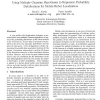Free Online Productivity Tools
i2Speak
i2Symbol
i2OCR
iTex2Img
iWeb2Print
iWeb2Shot
i2Type
iPdf2Split
iPdf2Merge
i2Bopomofo
i2Arabic
i2Style
i2Image
i2PDF
iLatex2Rtf
Sci2ools
ICRA
2000
IEEE
2000
IEEE
Using Multiple Gaussian Hypotheses to Represent Probability Distributions for Mobile Robot Localization
A new mobile robot localization technique is presented which uses multiple Gaussian hypotheses to represent the probability distribution of the robots location in the environment. Sensor data is assumed to be provided in the form of a Gaussian distribution over the space of robot poses. A tree of hypotheses is built, representing the possible data association histories for the system. Covariance intersection is used for the fusion o/the Gaussians whenever a data association decision is taken. However, such a tree can grow without bound and so rules are introduced for the elimination o/the least likely hypotheses from the tree and for the proper re-distribution of their probabilities. This technique is applied to a feature-based mobile robot localization scheme and experimental results are given demonstrating the effectiveness of the scheme.
ICRA 2000 | Mobile Robot Localization | Multiple Gaussian Hypotheses | Robot Localization Technique | Robotics |
Related Content
| Added | 25 Aug 2010 |
| Updated | 25 Aug 2010 |
| Type | Conference |
| Year | 2000 |
| Where | ICRA |
| Authors | David J. Austin, Patric Jensfelt |
Comments (0)

